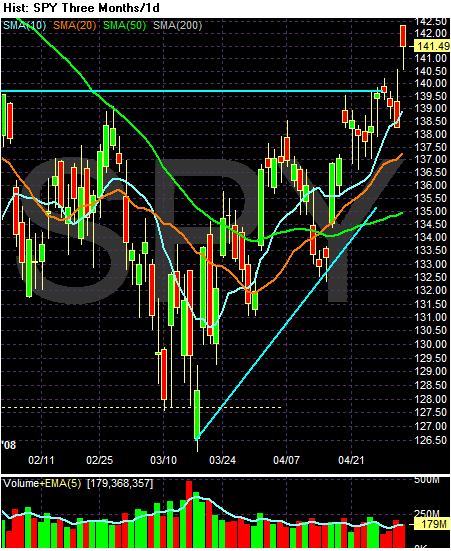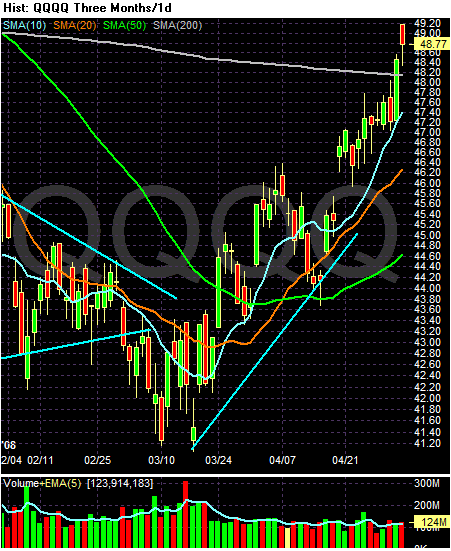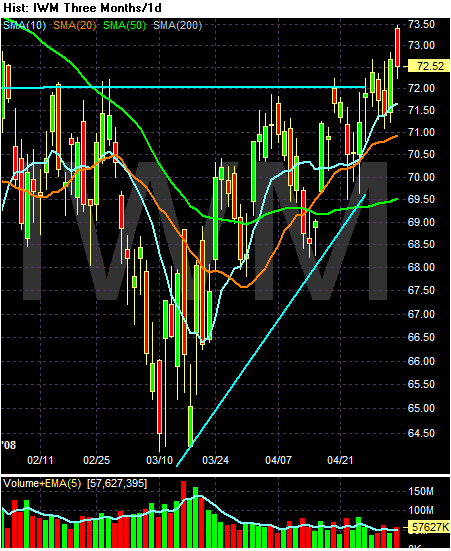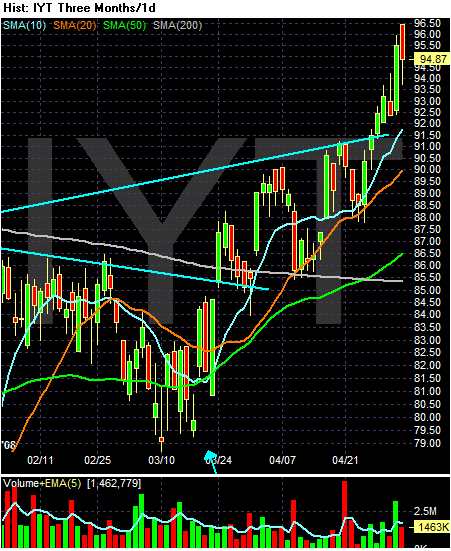
On the SPYs chart, notice the following:
-- Prices have been moving higher since mid-March
-- The shorter SMAs (10, 20 and 50) are above the longer SMAs
-- All the shorter SMAs are moving higher
-- Prices are above the SMAs

On the QQQQ chart, note the following:
-- Prices have been moving higher since mid-March
-- All of the shorter SMAs are moving higher
-- The shorter SMAs are higher than the longer SMA
-- Prices are above all the SMAs

On the IWM charts, notice the following:
-- Prices are above the shorter SMAs
-- All the shorter SMAs are heading higher
-- The shorter SMAs are moving higher
-- Prices have moved through key resistance levels

The Transports have confirmed the rally:
-- Prices have moved through the 5-year trend line
-- Prices are above all the SMas
-- The shorter SMAs ahve moved through the longer SMAs
-- The shorter SMAs have moved through the 200 day SMA
Barron's Trader Column outlined the basic perception that traders have of the market:
The recent barrage of monetary medicine -- including the seventh interest rate cut in eight months, administered last week -- has investors hopeful that a debilitating, protracted economic slump might have been averted. Still, most traders did not expect the government to report that the economy grew 0.6% in the first quarter. Pinch me please, Dr. Bernanke, but we're in a growing economy?
That unexpected -- though not unpleasant -- high was extended Friday by a report that showed employers cutting just 20,000 jobs in April. It was the fourth straight month of layoffs, but the toll was less than the 75,000 forecast, and investors tuning in for Recession '08, this season's most anticipated show, found themselves momentarily more befuddled than even Paula Abdul. Are we in a recession, were we ever in one and is it over yet?
The real question is will there be a recovery or will there be a protracted slowdown? The odds are about 50/50 for either.
Much will depend, of course, on rapidly increasing visions for a prompt economic recovery -- and how quickly companies can turn them into reality. Swiss Re's chief U.S. economist, Kurt Karl, thinks this downturn won't be severe but will likely be prolonged. Lower borrowing costs, tax rebates and the weak dollar "will keep the U.S. out of an acute recession," he says. "However, the full impact of the credit crisis, high oil prices and housing downturn has yet to be felt by consumers and businesses."
.....
"Wall Street believes that just because a systemic meltdown has been avoided, the crisis is over. It is not," says Charles Dumas, an economist with Lombard Street Research. Excessive private-sector debt will severely constrain domestic demand for years, and pre-emptive rate cuts "have sent oil and food prices sky-high, thus lowering real incomes and consumer confidence."
On the pro-recovery side we have an aggressive Federal Reserve, which has cut rates big time. Lower rates should help to prevent a big system wide meltdown. But are they enough to get the economy back into the 3% or greater growth per quarter? I seriously doubt it. Housing is still a wreck. The credit crisis is also in full swing largely because LIBOR is seriously out of whack. From the consumer side we have job losses, declining income and weak consumer sentiment as three big inter-related problems. Consumers are also in debt up to their eyeballs preventing a big increase in consumer spending. And then there are gas prices which hurt sentiment and spending big time. In short, there are a host of reasons for the economy to not grow at full potential. I think the Fed may have prevented a full-blown recession, but there are a ton of problems out there not going away anytime soon.
The FOMC statement presented a pretty dire picture of the US economy:
Recent information indicates that economic activity remains weak. Household and business spending has been subdued and labor markets have softened further. Financial markets remain under considerable stress, and tight credit conditions and the deepening housing contraction are likely to weigh on economic growth over the next few quarters.
Simply put, it doesn't gt much worse than that.
However, on Thursday the market rallied.
"The market is probably pleased that we may not see additional rate cuts going forward, since they've had the domino effect of pulling down the dollar and making oil prices higher," said Owen Fitzpatrick, head of the U.S. equity group at Deutsche Bank.
.....
The ability to borrow from the Fed is the catalyst that put the floor in for financial institutions, we're seeing financial institutions lend money, and some M&A deals announced," said Fitzpatrick.
And, recent capital offerings have succeeded in "allowing capital to flow back into financial stocks," the analyst said.
On Thursday there was also the better than expected news from the technology sector:
Symantec had the second-steepest rise in the S&P 500, gaining $2.12, or 12 percent, to $19.34. The world's biggest maker of security software said quarterly profit tripled, beating analysts' estimates, after businesses and consumers renewed subscriptions and bought more programs to protect information.
Intel added $1.03, or 4.6 percent, to $23.29. The world's largest chipmaker is stepping up production to meet higher-than- expected demand for Atom, a new processor for low-cost portable computers. Intel Chief Executive Officer Paul Otellini is using the processors to attract consumers who want stripped-down computers for word processing and surfing the Internet.
SanDisk gained $1.94, or 7.2 percent, to $29.03. The biggest maker of memory for digital cameras expects a sales boost from U.S. consumers spending their federal tax rebate checks, Chief Executive Officer Eli Harari said.
But Sun Micro showed a weaker tech sector:
Sun Microsystems Inc., citing impacts of the softening U.S. economy, posted a net loss on a slight decline in revenue for its third quarter and announced plans to cut up to 2,500 jobs.
But Sun was hit by a slowdown in tech spending in the U.S., said Sun Chief Executive Jonathan Schwartz in a conference call. "Our third quarter was a challenging one, in which U.S. macro factors impacted our overall performance," Mr. Schwartz said. In particular, Mr. Schwartz said the Santa Clara, Calif., technology company in March saw purchase decisions postponed because of economic uncertainty.
On Thursday, Mr. Lehman said the company will reduce its workforce by between 1,500 and 2,500 people, representing as much as 7.26% of its workforce, resulting in restructuring charges as high as $220 million.
Here's the short version: The market thinks the Fed has the situation in control. As a result, trader's are bidding up shares.